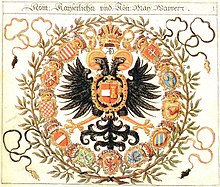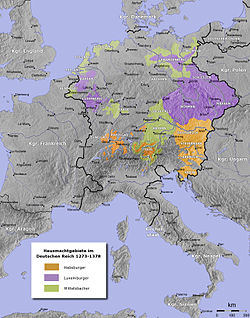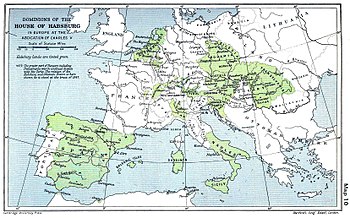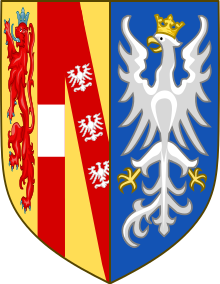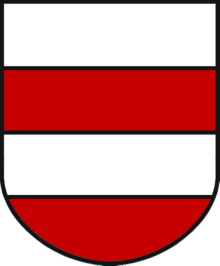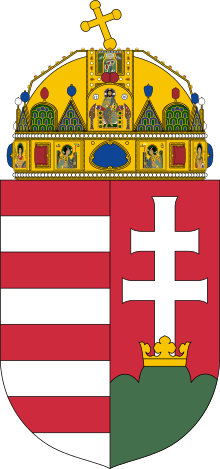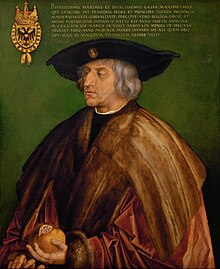House of Habsburg
The House of Habsburg, also called the House of Austria (German: Haus Österreich), was one of the most influential and powerful royal houses of Europe. The Habsburgs occupied the throne of the Holy Roman Empire continuously from 1438 to 1740 and at different times occupied the thrones of Spain, Portugal, Bohemia, England, Hungary, Croatia, and the Second Mexican Empire.
The Habsburgs originated from a modest castle in Aargau, present-day Switzerland. The founder of the dynasty, Count Radbot of Habsburg (c. 985-1045) came to control the castle as a vassal of the Duke of Swabia at the turn of the century XI. Through an ambitious marriage policy and alliances, the Habsburgs began to extend their influence until the 13th century Rudolf I of Habsburg, who by then already controlled parts of Alsace and Aargau, managed to be named King of the Romans in 1273 during the interregnum following the death of Frederick II of Hohenstaufen. The conflict between Rudolf I and the Hohenstaufen heir, King Ottokar II of Bohemia, resulted in the Habsburgs acquiring the territories of Austria, Styria, Carniola and Carinthia, which would form part of the family's core territories for the remainder of his story. In 1452 the influential Duke of Austria Frederick III was elected Holy Roman Emperor, and from that time until his dissolution the Habsburgs controlled the Holy Roman throne.
From the reign of Emperor Charles V (1519-1556), the House of Habsburg divided into two branches. The main branch of the Spanish Habsburgs, which ruled the Spanish Empire, became extinct in 1700 on the death of Charles II of Spain without issue. The cadet branch of the Austrian Habsburgs, which ruled the Holy Roman Empire and the territories of Austria-Hungary (and became the eldest after the disappearance of the Spanish), died out in the agnatic line in 1780 on the death of the empress Maria Theresa I of Austria (1717-1780). The descendants of Maria Theresa and her husband, Emperor Francis I of Lorraine (1708-1765), would found the House of Habsburg-Lorraine. Although this branch is dynastically part of the Vaudemont branch of the House of Lorraine, the House of Habsburg-Lorraine continues to the present day as a cognatic branch of the House of Habsburg.
The House of Habsburg-Lorraine would inherit the arms and names of the House of Habsburg, in addition to their vocation as Holy Roman Emperors, rulers of the various domains of the Habsburg Empire, and Grand Dukes of Tuscany. After the dissolution of the Holy Empire, he would go on to rule the Austro-Hungarian Empire. In current times, the head of the House of Habsburg was Prince Otto of Habsburg-Lorraine (1912-2011), who was the last Crown Prince of Austria-Hungary, and since 2007 Charles of Habsburg-Lorraine.
The Habsburgs were:
- Sovereigns of Austria (such as Dukes 1282-1453, Archdukes 1453-1804 and Emperors 1804-1918),
- Sovereigns in Germany as kings of Romans and emperors of the Holy Roman German Empire (1273-1308 and 1440-1806),
- Kings of Hungary (1437-1439, 1445-1457, 1526-1918),
- Kings of Croatia (1437-1439, 1445-1457, 1526-1918),
- Kings of Bohemia (1306-1307, 1437-1439, 1453-1457, 1526-1918),
- Kings of Spain (1516-1700),
- Kings of Portugal (1580-1640),
- Kings of Galitzia and Lodomeria (1772-1918),
- Princes of Transylvania (1690-1867),
- Great Dukes of Tuscany (1737-1801; 1814-1860)
- King of Sardinia (1713-1720)
- Duques de Parma (1814-1847),
- Duchess of Modena (1814-1859),
- Emperor of Mexico (1863-1867).
From counts to emperors
The name comes from the Swiss castle Habichtsburg (Hawk Castle), the Habsburg family residence during the 11th, 12th and 13th centuries, in what is now the Canton of Aargau, in the former duchy of Swabia, in the present-day Switzerland (Switzerland did not then exist in its current form, and Swiss lands were primarily part of the Holy Roman Empire.) From southwestern Germany (mainly Alsace, present-day France, Breisgau, Aargau, and Thurgau) the family extended its influence and settlements to the southeastern ends of the Holy Roman Empire, roughly what is present-day Austria (1278-1382). In just two or three generations, the Habsburgs had managed to gain an initially intermittent hold on the imperial throne that would last for centuries (1273-1291, 1298-1308, 1438-1740, and 1745-1806).
Following Maximilian I's marriage to Mary, heiress to Burgundy (who controlled the Netherlands) and the marriage of his son Philip the Fair to Joan, heiress to Spain and its newly founded empire, Charles V inherited Spain, Italy from the south, Austria and the Netherlands. In 1580 his son Philip II inherited Portugal and its colonies.
Under Maximilian II, the Habsburgs first acquired the land where they would later build Schönbrunn Palace: the Habsburg summer palace in Vienna and one of the dynasty's most enduring symbols.
Division of the House: the Austrian Habsburgs and the Spanish Habsburgs
After the assignment on April 21, 1521, of the Austrian lands to Ferdinand I, by his brother, Emperor Charles V (also King Charles I of Spain) (1516-1556), the dynasty split into a branch Austrian and Spanish. The Austrian Habsburgs carried (after 1556) the title of Holy Roman Emperor, as well as the Habsburg hereditary lands and the Kingdoms of Bohemia and Hungary, while the Spanish Habsburgs ruled over the Spanish kingdoms, the Netherlands, the Spanish possessions in Italy from the Crown of Aragon, and for a time, Portugal. Hungary, nominally under Habsburg rule from 1526 but mostly under Ottoman Turkish occupation for 150 years, was reconquered in 1683-1699.
The Spanish Habsburgs disappeared in 1700 due to a completely diminished and incapable king, Carlos II of Spain although the Spanish Habsburg dynasty continued with the descent of Don Juan José of Austria (the only illegitimate son recognized by Philip IV) and Don Carlos Fernando de Austria y Manrique. After the death of Carlos II the War of the Spanish Succession took place, something that would be repeated with the Austrian Habsburgs in 1740, originating the War of the Austrian Succession. However, the last Austrian Habsburg heiress (María Teresa) married Francisco Esteban, Duke of Lorraine, both great-grandsons of the Habsburg Emperor Ferdinand III, but from different empresses. Her descendants continued the tradition of the Vienna Habsburgs under the dynastic name Habsburg-Lorraine. It is often speculated that consanguineous marriages between the two lines contributed to their extinction, but there were few such marriages in the Austrian line. The death of the young heiresses from smallpox was the cause.
House of Habsburg-Lorraine: the Austrian Empire
On August 6, 1806, the Holy Roman Empire was dissolved under French Emperor Napoleon Bonaparte's reorganization of Germany. However, in anticipation of losing his title of Holy Roman Emperor, Francis II declared himself hereditary Emperor of Austria (as Francis I) on August 11, 1804, three months after Napoleon had declared himself. declared himself Emperor of the French on May 18, 1804.
Emperor Francis I of Austria used the grand official title: 'Francis I, by the grace of God Emperor of Austria; King of Jerusalem, Hungary, Bohemia, Dalmatia, Croatia, Slavonia, Galicia and Lodomeria; Archduke of Austria; Duke of Lorraine, Salzburg, Wurzburg, Franconia, Styria, Carinthia, and Carniola; Grand Duke of Krakow; Grand Prince of Transylvania; Margrave of Moravia; Duke of Sandomir, Masovia, Lublin, Upper and Lower Silesia, Auschwitz and Zator, Teschen and Friuli; Prince of Berchtesgaden and Mergentheim; Count of Habsburg, Gorizia and Gradisca and of Tyrol; and Margrave of Upper and Lower Lusatia and Istria, Lord of the Lands of Volhynia, Podlachein and Berzesz, of Trieste, of Freudenthal and Eulenburg and of the Vindic March."
In 1867 Hungary was given effective autonomy under the terms of the Ausgleich or 'compromise' (see Austro-Hungarian Empire) until the deposition of the Habsburgs of Austria and Hungary in 1918 after defeat in World War I.
The current leader of the Habsburg family is Charles of Habsburg-Lorraine, the eldest son of Archduke Otto.
The Habsburgs in Germany: Holy Roman Emperors and Kings of the Romans
- Rodolfo I, king of Romans (1273-1291).
- Alberto I, king of Romans (1298-1308).
- Federico The BeautifulKing of Romans rival between 1314 and 1325, and legitimate between 1326 and 1330.
- Alberto II, king of Romans (1438-1439).
- Frederick III, king of Romans (1440-1452) and then emperor until 1493.
- Maximilian I, king of Romans (1486-1508) and then emperor-elect until 1519.
- Charles V, king of Romans (1519-1520), emperor-elect in 1520 and crowned in 1530; his abdication was not recognized until 1558.
- Fernando I, king of Romans (1531-1558) and then emperor (1558-1564).
- Maximilian II, king of Romans (1562-1564) and then emperor (1564-1576).
- Rodolfo II, king of Romans (1575-1576) and then emperor (1576-1612).
- Matías, emperor (1612-1619).
- Fernando II, emperor (1619-1637).
- Fernando III, king of Romans (1636-1637) and then emperor (1637-1657).
- Fernando IV, king of Romans (1653-1654).
- Leopoldo I, emperor (1658-1705).
- Joseph I, king of Romans (1690-1705) and then emperor (1705-1711).
- Charles VI, emperor (1711-1740).
- Joseph II, king of Romans (1764-1765) and then emperor (1765-1790).
- Leopoldo II, emperor (1790-1792).
- Francis II, emperor (1792-1806).
The Habsburgs in Austria and Spain
Before Rudolf's accession to King of Germany, the Habsburgs were Counts in what is now southwestern Germany and Switzerland.
Ancestors
- Guntram, the Rico (ca. 930-985/990). Father of:
- Lanzelin de Altenbourg (f. 991). In addition to Radbot, he had children named Rodolfo I, Werner and Landolfo.
Counts of Habsburg
- Radbot I of Klettgau built Habsburg Castle (ca. 985-1035). In addition to Werner I, he had two more children: Oton I, who would become Count of Sundgau in Alsace and Alberto I.
- Werner I, Count of Habsburg (1025/1030-1096). In addition to Othon II, he had another son, Alberto II, who was deputy of Muri from 1111 to 1141 following the death of Othon II.
- Othon II of Habsburg; the first to call himself "from Habsburg" (f. 1111). Father of:
- Werner II of Habsburg (about 1135; f. 1167). Father of:
- Albert III of Habsburg (el Rico), f. 1199. With him, the territories of the Habsburgs expanded to cover most of what is now the German-speaking Switzerland. Father of:
- Rodolfo II of Habsburg (f. 1232). Father of:
- Alberto IV de Habsburg (f. 1239/1240), father of Rodolfo IV of Habsburg, who would later be king of Romans Rodolfo I. Between Alberto IV and his brother Rodolfo III the properties of the Habsburgs were divided, Alberto remained the parts of the west and Argovia and Rodolfo III the parts of the east (Laufenburg, Waldshut, Klekgau), which would give rise to the Habsburg-Laufenburg branch.
Secondary branch: Habsburg-Laufenburg and Habsburg-Klettgau
After the death of Rudolf III in 1229 and of his son Godfrey I in 1271, the Habsburg-Laufenburg divided into the lords of Laufenburg and the counts of Klekgau. The first branch of Laufenburg derives from Rodolfo IV (†1315), Godfrey's son, and became extinct in 1408 when John IV died. The second branch of Klekgau derives from Eberhard I, Godfrey's son, and died out in 1415 when Eggon II died, reuniting his territories with the main line of the Habsburgs.
Main Branch: Dukes of Austria
In the late Middle Ages, when the Habsburgs expanded their territories to the east, they often ruled as dukes of the Duchy of Austria which covered only what is now Lower Austria and the eastern part of Upper Austria. The Habsburg possessions also included Styria, and they then expanded westward to include Carinthia and Carniola in 1335 and Tyrol in 1363. Their original scattered possessions in southern Alsace, southwestern Germany, and Vorarlberg were collectively known as Former Austria. The Habsburg dukes gradually lost their original lands south of the Rhine and Lake Constance to the expansion of the Old Swiss Confederacy. The dukes of Austria also ruled Former Austria until 1379; from that year, Former Austria was ruled by the Count of Tirol.
- Rodolfo I, son and successor of Alberto IV, Count of Habsburg since 1240 and also Duke of Austria, Styria, Carinthia and Carniola (1278-1282), King of Romans (1273-1291).
- Alberto I, son of Rodolfo I and brother Rodolfo II, Duke (1282-1308); he was king of Romans (1298-1308).
- Rodolfo II, son of Rodolfo I, Duke of Austria and Styria along with his brother (1282-1283), was dispossessed by his brother, who would be killed by one of the sons of Rodolfo, Juan el Parricida.
- Rodolfo III, the eldest son of Alberto I, appointed Duke of Austria and Styria (1298-1307).
- Federico I The Beautiful (Friedrich der Schöne), brother of Rodolfo III. Duke of Austria and Styria (1308-1330). Elected king rival of Romans between 1314 and 1325, and recognized as such by Emperor Louis IV since 1326.
- Leopoldo I, brother of the former, Duke of Austria and Styria (1308-1326).
- Alberto II, brother of the two precedents, Duke in Austria Previous (1326-1358), Duke of Austria and Styria (1330-1358), Duke of Carinthia and Carniola after 1335.
- Oton el Alegreder Fröhliche), brother of the former, Duke of Austria and Styria (1330-1339) together with his brother, Duke of Carinthia and Carniola after 1335. His children succeeded him nominally, as they were both minor:
- Frederick II (1339-1344) and
- Leopoldo II (1339-1344).
- Oton el Alegreder Fröhliche), brother of the former, Duke of Austria and Styria (1330-1339) together with his brother, Duke of Carinthia and Carniola after 1335. His children succeeded him nominally, as they were both minor:
Because they both died young, their rights reverted to their uncle Albert II.
On the death of Alberto II (1358), his sons Rodolfo IV, Federico III (duke of Carinthia, †1362), Alberto III and Leopold III inherited; but since the last three were minors, the effective government was exercised by Rodolfo IV.
- Rodolfo IV the Founder (der Stifter), the eldest son of Alberto II. Duke of Austria and Styria (1358-1365), Count of Tyrol after 1363.
On the death of Rudolf IV, his brothers Albert III and Leopold III ruled together the Habsburg possessions from 1365 to 1379, when they divided the territories in the Treaty of Neuberg, Alberto remaining the Duchy of Austria and Leopold Styria ruling, Carinthia, Carniola, Tyrol and Austria Previous.
A. Albertine Line: Dukes of Austria
- Alberto III, Duke of Austria from 1365 to 1395 (from 1386, Leopoldo died also ruled on the possessions of this), Count of Tyrol (1365-1395).
- Alberto IV, Duke of Austria (1395-1404), in conflict with Leopoldo IV.
- Alberto V, Duke of Austria (1404-1439), King of Romans (1438-1439) as Alberto II.
- Ladislao Posthumousson of the former, Duke of Austria (1440-1457).
B. Leopold line: Dukes of Styria, Carinthia, Carniola, Tyrol
- Leopoldo III, Duke of Styria, Carinthia, Carniola, Tyrol and Austria Previous from 1365 to 1386, when he died in the Battle of Sempach.
- Guillermo, son of Leopoldo III, Duke of Austria Interior (Carinthia, Carniola, Estiria) (1386-1406).
- Leopoldo IV, son of Leopoldo III, corgent with his brother William, since 1391 Duke in Austria Previous, Count of Tyrol (1395-1411).
B.1. Leopoldina-Inner Austria subline
- Ernesto el Férreoder Eiserne), Duke of Austria Interior (1406-1424). He was William's brother and successor.
- Federico V, son of Ernesto, king of Romans in 1440 and Emperor in 1452. He was Duke in Austria Interior from 1424 to 1493 with his brother Alberto VI. Guardian of Segismund (1439-1446) and Ladislao Póstumo (1440-1452). At the death of Ladislaus (1457), he acquired the duke of Austria.
- Alberto VI, son of Ernesto, was Duke in Austria Interior from 1424 to 1463 with his brother Federico V, regent of Austria Previous (1446-1463), Duke of Austria (1457-1463) to the death of Ladislao (1457).
B.2. Leopoldina-Tirol subline
- Federico IV, brother and successor of Leopoldo IV, Count of Tyrol since 1406 and Duke in Austria Previous since 1411. He died in 1439.
- Segismundo, count of Tyrol and Duke in Austria Previous (1439-1490). Until 1446 under the tutelage of Federico V.
Sigismund had no children and adopted Maximilian I, son of Duke Frederick V (Emperor Frederick III). With Maximilian, the Habsburg possessions would be united again under a single ruler, after he reconquered the Duchy of Austria after the death of Matthias Corvino, who resided in Vienna and named himself Duke of Austria (1485-1490).
- Maximilian I, Archduke of Austria (1493-1519), King of Romans (1486-1508) and then Elect Emperor until 1519.
- Charles I, Archduke of Austria (1519-1521), King of Romans (1519-1520), Emperor elected in 1520 and crowned in 1530; his abdication was not recognized until 1558; King of Spain (1516-1556). Carlos I, Archduke of Austria and King of Spain (emperador Carlos V), divided the House of Habsburg into the Austrian and Spanish lines.
Spanish Habsburgs: Kings of Spain (1516-1700) and Kings of Portugal (1580-1640)
The Habsburgs reigned in Spain constituting the lineage called House of Austria. Consequently, each of those monarchs and their entire lineage bore the of Austria , and never the of Habsburg as their family name. This is how it appears in all kinds of documents, inscriptions, tombstones, contemporary artistic creations, etc. Only since the end of the s. XX the use of the Habsburg surname began to generalize imprecisely to refer to those of the dynasty that ruled Spain for centuries XVI and XVII.
- Felipe I of Castile, the second son of Maximilian I, married Juana la Loca, daughter of the Catholic Kings and thus became king of Castile in 1506 and predecessor of the House of Habsburg in Spain.
- Charles I (1516-1556), emperor-elect in 1520 and crowned in 1530, whose abdication was not recognized until 1558; he divided the House of Habsburg into the Austrian and Spanish lines.
- Philip II of Spain (1556-1598), also Philip I of Portugal (1580-1598).
- Philip III, also Philip II of Portugal (1598-1621).
- Philip IV (1621-1665), also Philip III of Portugal (1621-1640).
- Charles II (1665-1700).
With Carlos II the line of the Spanish Habsburgs was extinguished. After the Spanish Succession War, the Austrian Habsburgs were denied access to the Spanish throne for the benefit of the House of Bourbon.
Austrian Habsburgs: Holy Roman Emperors, Archdukes of Austria
- Fernando I, brother and successor of Emperor Charles V, archduke of Austria (1521-1564), king of Romans (1531-1558) and then emperor (1558-1564).
A. Line of the Archdukes of Austria
- Maximilian II, son and successor of Emperor Ferdinand I, archduke of Austria (1564-1576), king of Romans (1562-1564) and then emperor (1564-1576).
- Rodolfo II, son and successor of Emperor Maximilian II, Archduke of Austria. Rodolfo V (1576-1608), king of Romans (1575-1576) and then emperor (1576-1612).
- Matías, brother and successor of Emperor Rodolfo II, Archduke of Austria (1608-1619), emperor (1612-1619).
- Maximilian III, brother of Rodolfo II and Matías, was governor of Tyrol between 1612 and 1618.
B. Austria-Styria line
- Charles II, son and successor of Emperor Ferdinand I, Archduke in Austria Interior (Stiria, Carinthia, Carniola) (1564-1590).
- Fernando II, son of the precedent, archduke in Austria Interior (1590-1637), brought together the two family branches as successor of Emperor Matías in 1619; he was elected emperor (1619-1637).
C. Austria-Tyrol line
- Fernando II, son and successor of Emperor Ferdinand I, Count of Tyrol (1564-1595). Because his male offspring derived from his morganal marriage, his inheritance passed to Rodolfo II and then to the emperors Matías and Fernando II.
The descendants of Emperor Ferdinand II's brother (Archduke Ferdinand III) were Archdukes in Former Austria and Counts of Tirol since the Emperor ceded these territories to him in 1623.
- Leopoldo V, brother of Emperor Ferdinand II, was assigned to him by the government of Tyrol and Austria Previous in 1619, and in 1623 this territory was left for his offspring. He died in 1632.
- Fernando Carlos, Archduke in Austria Previous and Tyrol (1628-1662).
- Segismundo Francisco, archduke in Austria Previous and Tyrol (1662-1665); brother and successor to the precedent, his un descended death reversed his territories to the main branch, to Emperor Leopoldo I.
Holy Roman Emperors, Archdukes of Austria: Reunited Territories
- Leopoldo VI, Archduke of Austria and Emperor (1658-1705).
- Joseph I, archduke of Austria (1705-1711), king of Romans (1690-1705) and then emperor (1705-1711).
- Charles III, Archduke of Austria and Emperor (1711-1740).
- Mary Teresa, heir to the Habsburgs and wife of Emperor Francis I (1745-1765), Duke of Lorena, reigned as Archduchess of Austria and Queen of Hungary and Bohemia (1740-1780).
With Maria Teresa, the House of Habsburg as such ended, which led to the House of Habsburg-Lorraine. The new Royal House arose when Emperor Charles VI of the Holy Roman Empire in his last years of life issued the Pragmatic Sanction of 1713, where it was established that his daughter Maria Teresa I of Austria would be the Germanic Empress and her husband alone. his consort. Thus, the children of María Teresa and Francisco de Lorena would be the members of the new dynasty.
House of Habsburg-Lorraine
Habsburg-Lorraine, Main Line: Holy Roman Emperors, Archdukes of Austria

- Joseph II, archduke of Austria (1780-1790), king of Romans (1764-1765) and then emperor (1765-1790).
- Leopoldo VII, Archduke of Austria and Emperor (1790-1792).
- Francis I, Archduke of Austria and Emperor (1792-1806).
The House of Habsburg-Lorraine retained Austria and its attached possessions after the dissolution of the Holy Roman Empire.
A son of Leopold II was Rainier of Austria, whose wife was of the House of Savoy; a daughter Adelaide, Queen of Sardinia, was the wife of King Victor Emmanuel II of Piedmont, Savoy and Sardinia and King of Italy. Her children married into the Royal Houses of Bonaparte; Saxe-Coburg-Gotha (Braganza, Portugal); Savoy (Spain), and the duchies of Montferrat and Chablis.
Habsburg-Lorraine, main line: Emperors of Austria
- Francis I, emperor of Austria (1804-1835): was also Francis II of the Holy German Roman Empire.
- Fernando I, emperor of Austria (1835-1848).
- Francis Joseph, emperor of Austria (1848-1916).
- Charles I, emperor of Austria (1916-1918). He died in exile in 1922. His wife, Empress Zita, belonged to the Ducal House of the Bourbon-Parma.
House of Habsburg-Lorraine, main line: Heads of the House of Habsburg (post-monarchy). Carlos I was expelled from his domain after the First World War with the dissolution of the Austro-Hungarian Empire. He and his family lost the right of inheritance or any royal distinction.
- Carlos I (1918-1922).
- Oton de Habsburg (1912-2011).
- Zita de Borbón-Parma, guardian (1922-1930).
- Carlos de Habsburg-Lorena, who obtained in 2007 his dynastic rights for the abdication of his father, Oton.
Sovereign minor branches of the House of Habsburg-Lorraine
House of Austria-Tuscany: Grand Dukes of Tuscany
- Francis II Esteban (1737-1765) (after Francis I, Emperor of the Holy Roman German Empire).
Francis II assigned the Grand Duchy of Tuscany to his second son Peter Leopold, who in turn assigned it to his second son after his ascension as Holy Roman Emperor. Tuscany remained the domain of this cadet branch of the family until the unification of Italy.
- Pedro Leopoldo (1765-1790) (later Leopoldo II, Emperor of the Holy Roman German Empire).
- Fernando III (1790-1800, 1814-1824).
- Leopoldo II (1824-1849, 1849-1859).
- Fernando IV (1859-1860).
House of Austria-Tuscany: Tuscany line, post-monarchy
- Fernando IV (1860-1908).
- Archduke Pedro Fernando, Prince of Tuscany (1908-1948).
- Archiduque Gottfried, Prince of Tuscany (1948-1984).
- Archduke Leopoldo Francisco, Prince of Tuscany (1948-1993).
- Archiduque Sigismund, Grand Duke of Tuscany (1993-present).
House of Austria-Este: Duchy of Modena
The dukedom of Modena was assigned to a lesser branch of the family by the Congress of Vienna. It was lost with the unification of Italy.
- Francis IV (1814-1831, 1831-1846).
- Francis V (1846-1848, 1849-1859).
House of Austria-Este: Modena line, post-monarchy
- Francis V (1859-1875).
- Francisco Fernando, Archduke of Austria-Este (1875-1914).
- Carlos, Archduke of Austria-Este (1914-1917).
- Roberto, Archduke of Austria-East (1917-1996).
- Prince Lorenzo, Archduke of Austria-East (1996-present).
House of Habsburg-Lorraine: Duchy of Parma
The duchy of Parma was also assigned to a Habsburg, but he was not in the House for long before succumbing to the unification of Italy. It was awarded to the second wife of Napoleon Bonaparte, Maria Luisa Duchess of Parma, a daughter of Francis II, Holy Roman Emperor, who was the mother of Napoleon II of France. Napoleon had divorced his barren wife Marie Josèphe Rose Tascher de la Pagerie (better known to history as Josephine de Beauharnais) in favor of Marie Louise.
- María Luisa (1814-1847).
House of Habsburg-Lorraine: Emperor of Mexico
Maximilian, brother of the Austrian Emperor Francisco José, was convinced by a Mexican delegation from the Conservative Party, the Catholic Church and Napoleon III to assume the throne of Mexico. The Mexican Empire ended in a military defeat by the liberal party, since French military support was withdrawn prematurely due to internal problems that the French emperor had, coupled with the defeats that liberal Mexicans caused the French army. Maximiliano was shot by the Republican troops of Benito Juárez in the Cerro de las Campanas in Querétaro in 1867.
- Maximilian I (1863-1867).
Non-sovereign minor branches of the House of Habsburg-Lorraine
House of Austria-Teschen: Dukes of Teschen
The duchy of Teschen was succeeded by Charles of Austria-Teschen, son of Leopold II and Maria Luisa de Bourbon, commander-in-chief of the Austrian army during the Napoleonic wars.
- Charles of Austria-Teschen, Duke of Teschen (1771-1847).
- Albert of Austria-Teschen, Duke of Teschen.(1847-1895).
- Frederick of Austria-Teschen, Duke of Teschen. (1895-1918).
House of Austria-Teschen: post-monarchy
- Federico de Austria-Teschen, duke holder of Teschen (1918-1936).
- Francisco Alberto of Austria-Teschen, head of Teschen. (1946-1955).
Hohenberg House
The Ducal House of Hohenberg descends from Countess Sophie Chotek (1868-1914), who in 1900 married Archduke Franz Ferdinand of Austria-Este (1863-1914), the heir to the throne of Austria-Hungary. As her marriage was morganatic, none of her children were in the line of succession to the Austro-Hungarian throne for which, on her death, Archduke Charles, later Charles I, would inherit the throne. They represent the upper agnatic line of the House of Habsburg-Lorraine.
- Sophie, duchess of Hohenberg (1868-1914), former Hohenberg princess since the time of her marriage in 1900.
- Maximilian Hohenberg, Duke of Hohenberg (1902-1918).
House of Hohenberg: post-monarchy
- Maximilian Hohenberg, Duke of Hohenberg (1918-1962).
- Franz de Hohenberg, Duke of Hohenberg (1927-1977).
- Georg de Hohenberg, Duke of Hohenberg (1929–2019).
Habsburgs as Kings of Hungary
The kingdom of Hungary remained in the Habsburg family for centuries; but as the kingdom was not strictly inherited (Hungary was an elective monarchy until 1687) and was sometimes used as a training ground for young Habsburgs, the dates of rule do not always fit with those of the main Habsburg possessions. Therefore, the kings of Hungary are listed separately.
Albertine Line: Kings of Hungary
- Alberto, King of Hungary (1437-1439).
- Ladislao V PosthumousKing of Hungary (1440/1444-1457).
Austrian Habsburgs: Kings of Hungary
- Fernando I, King rival of Hungary (1526-1538); King of Hungary (1540-1564).
- Maximilian I, king of Hungary (1563-1576).
- Rodolfo I, King of Hungary (1572-1608).
- Matías, king of Hungary (1608-1619).
- Fernando II, King of Hungary (1618-1637).
- Fernando III, King of Hungary (1625-1657).
- Fernando IV, King of Hungary (1647-1654).
- Leopoldo I, king of Hungary (1655-1705).
- Joseph I, king of Hungary (1687-1711).
- Charles III, King of Hungary (1711-1740).
- Mary Teresa, Queen of Hungary (1740-1780).
House of Habsburg-Lorraine, Main Line: Kings of Hungary
- Joseph II, King of Hungary (1780-1790).
- Leopoldo II, King of Hungary (1790-1792).
- Francis, King of Hungary (1792-1835).
- Fernando V, King of Hungary (1835-1848).
- Francis Joseph I, King of Hungary (1848-1916).
- Charles IV, King of Hungary (1916-1918).
Habsburgs as Kings of Bohemia
The kingdom of Bohemia was for centuries a position of choice for its nobles. As a result, it was not an automatically inherited position. The Bohemian king tended to be a Habsburg, but not always. Thus, the kings of Bohemia and their dates of rule are listed separately.
Main line: Kings of Bohemia
- Rodolfo I, king of Bohemia (1306-1307).
Albertine Line: Kings of Bohemia
- Alberto, king of Bohemia (1437-1439).
- Ladislaus the Postumus, king of Bohemia (1453-1457).
Austrian Habsburgs: Kings of Bohemia
- Fernando I, king of Bohemia (1526-1564).
- Maximilian I, king of Bohemia (1562-1576).
- Rodolfo II, King of Bohemia (1575-1611).
- Matías, king of Bohemia (1611-1619).
- Fernando II, King of Bohemia (1617-1619; 1620-1637).
- Fernando III, King of Bohemia (1627-1657).
- Fernando IV, King of Bohemia (1646-1654).
- Leopoldo I, king of Bohemia (1656-1705).
- Joseph I, king of Bohemia (1705-1711).
- Charles II, King of Bohemia (1711-1740).
House of Habsburg-Lorraine, main line: Kings of Bohemia
Since the accession of Maria Theresa, the kingdom of Bohemia was united with the Austrian possessions.
- Mary Teresa, Queen of Bohemia (1740-1780).
- Joseph II, King of Bohemia (1780-1790).
- Leopoldo II, King of Bohemia (1790-1792).
- Francis, King of Bohemia (1792-1835).
- Fernando V, King of Bohemia (1835-1848).
- Francis Joseph I, king of Bohemia (1848-1916).
- Charles III, King of Bohemia (1916-1918).
Habsburgs as Queen Consorts of France
Given that since modern times the interests of the territories governed by the Habsburgs (Austria and Spain) and those governed by the successor dynasties of the Capetians (Valois and Bourbon) collided, an attempt was made to ease the tensions by arranging marriages with kings of France.
Austrian Habsburgs
- Isabel of Austria, wife of King Charles IX of France.
- Leonor of Austria, infant of Spain (1498-1558), wife of King Francis I of France.
Spanish Habsburgs
- Ana de Habsburg, Infanta de España, (1601-1666), wife of King Louis XIII.
- María Teresa of Spain (1638-1683), wife of King Louis XIV.
Habsburg-Lorraine
- Marie Antoinette (1755-1793), wife of King Louis XVI.
- Queen Mary Cristina of Austria, granddaughter of Leopoldo II of Austria. Spouse of Alfonso XII of Spain and mother of Alfonso XIII.
Ascension to the throne of the Holy Roman Empire
The Habsburgs first acceded to the German throne in 1273, under Rudolf I (1218-1291). They had previously obtained the duchies of Austria, Styria and Carniola. They once again held the Imperial Crown in the time of their son Alberto I (1250-1308), elected in 1298, after the interregnum of Adolf of Nassau, whom he dethroned. However, he barely managed to stay as King of Germany, thanks to the support of France, Bohemia and the Papacy, because many German princes opposed it until he was assassinated by his own nephew, John of Swabia, passing the Imperial Crown to the House from Luxembourg. They again got the imperial crown in 1438, with Albert II (1397-1439). Thereafter, although the imperial dignity remained theoretically elective, it remained attached to the House of Habsburg until the demise of the Holy Empire (with a brief interruption in 1740-1745). He was succeeded at the head of the House and the Empire by his cousin Frederick III of Habsburg (1415-1493), who began the series of marriages that extended the domains of the House to Western Europe, by marrying his son Maximilian I (1459- 1519) with Mary of Burgundy, who provided the Habsburgs with the vast Burgundian territories of the Netherlands and Franche-Comté. His son Felipe I el Hermoso (1478-1506), was king of Castile by marriage to the heiress of the Catholic Monarchs, Juana I la Loca. Their son, Charles V (1500-58), reigned in Spain under the name of Charles I, before being elected emperor in 1519. Charles's inheritance brought together Austria, the Netherlands, Franche-Comté, Castilla (with Navarre, Granada and the recently discovered Indies) and the Crown of Aragon (with Naples, Sicily and Sardinia). With him the power of the House reached its apogee, coming to conceive an ideal of a universal Christian Monarchy, which failed before the resistance opposed to his plans by France and by the Protestant reform, which split Western Christianity. In practice it was only the most powerful of the Western European authoritarian monarchies with which it competed. When he abdicated in 1556, Carlos divided his domains between his brother Fernando and his son Felipe, thus creating two branches of the family, settled respectively in Austria and Spain.
Ferdinand I (1503-1564) received the Empire in 1558 together with the original patrimonial domains of the House in Austria. His marriage also provided him with Bohemia and Hungary. When he died, the Austrian branch of the House was divided, in turn, into three lines: the Habsburgs of Austria (Rudolfo II and Matías, with whom this line died out in 1619), those of Tyrol (which died out in 1666) and those of Styria (Fernando II, Fernando III, Leopoldo I, José I…). The latter inherited the imperial dignity and ended up reuniting the domains distributed since the death of Fernando I.
End of the Holy Roman Empire
The Peace of Westphalia of 1648 meant the loss of real power of the emperor and greater autonomy for the three hundred and fifty resulting states. For all intents and purposes, the Holy Roman Empire became a confederation of states. Later, the League of the Rhine was created in 1658, which interfered even more in the power of the House of Austria in Spain.
Francis II (r. 1792-1806) was the last ruler of the Holy Roman Empire, officially dissolved on August 6, 1806 following the military victories of Napoleon Bonaparte. The wars against France resulted in the end of Austrian rule over the Netherlands and the Milanese (1797), as well as their domains on the left bank of the Rhine (1801).
Contenido relacionado
5
1890s
2nd century BC c.

